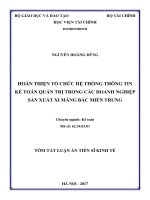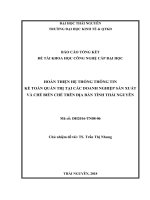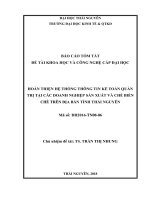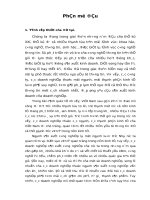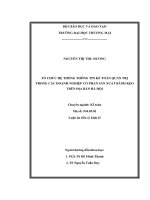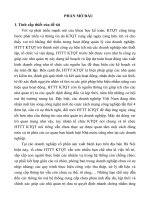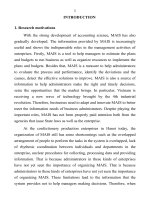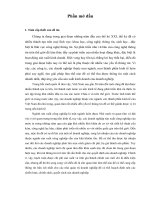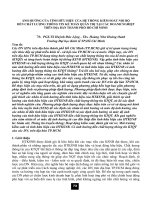Tổ chức hệ thống thông tin kế toán quản trị trong các doanh nghiệp cổ phần sản xuất bánh kẹo trên địa bàn hà nội tt tiếng anh
Bạn đang xem bản rút gọn của tài liệu. Xem và tải ngay bản đầy đủ của tài liệu tại đây (139.29 KB, 24 trang )
1
INTRODUCTION
1. Research motivations
With the strong development of accounting science, MAIS has also
gradually developed. The information provided by MAIS is increasingly
useful and shows the indispensable roles in the management activities of
enterprises. Firstly, MAIS is a tool to help managers to estimate the plans
and budgets to run business as well as organize resources to implement the
plans and budgets. Besides that, MAIS is a measure to help administrators
to evaluate the process and performance, identify the deviations and the
causes, detect the effective solutions to improve. MAIS is also a source of
information to help administrators make the right and timely decisions,
seize the opportunities that the market brings. In particular, Vietnam is
receiving a new wave of technology brought by the 4th industrial
revolution. Therefore, businesses need to adapt and innovate MAIS to better
meet the information needs of business administrators. Despite playing the
important roles, MAIS has not been properly paid attention both from the
agencies that issue State laws as well as the enterprise.
At the confectionery production enterprises in Hanoi today, the
organization of MAIS still has some shortcomings such as the overlapped
arrangement of people to perform the tasks in the system is overlapped, lack
of rhythmic coordination between individuals and departments in the
enterprise, unclear procedures for collecting, processing data and providing
information. That is because administrators in these kinds of enterprises
have not yet seen the importance of organizing MAIS. That is because
administrators in these kinds of enterprises have not yet seen the importance
of organizing MAIS. These limitations lead to the information that the
system provides not to help managers making decisions. Therefore, when
2
managers need information for making decisions or planning business
production, there is almost no reliable basis to practice.
Stemming from the mentioned issues, the author chose the topic
"Organizing
management
accounting
information
system
in
confectionery manufacturing enterprises in Hanoi" for doctoral thesis
research.
2. Literature overview
The author has reviewed the domestic and international kinds of
literature related to the research issue and divided them into two segments:
(1) The researches on the AIS organization and the MAIS
organization.
(2) The studies on factors affecting the AIS organization and the
MAIS organization.
Thereby, the author realizes unexplained gaps following:
- The studies have not mentioned the requirements to set up the MAIS.
Although some studies have taken a multi-perspective approach, the studies
have not fully and clearly shown the issue of the MAIS organization. There
are very few studies published considering the MAIS organization with the
trend of the information integration systems and big data.
- The domestic studies have mainly used qualitative research methods
to give the factors affecting the MAIS organization. Very few projects
studies put forward models and test factors affecting the MAIS organization
in manufacturing enterprises.
- The studies related to AIS, MAS though diverse in types of
businesses. However, there has not been any study on MAIS organization in
confectionery manufacturing enterprises in Hanoi.
3
3. Objectives and Missions
Objectives: The objective of the thesis is to study and propose solutions
to perfect the MAIS organization of confectionery manufacturing joint-stock
enterprises in Hanoi to meet management requirements in the context of
globalization and implementation of the industrial revolution 4.0
Missions:
- Studying and shedding out theories framework about the MAIS
organization in manufacturing enterprises in a multi-perspective approach
(the components of the system, the information contents, the information
function of the system) and placing it in the context of technology 4.0, the
system integrates information. In addition to the concepts and nature of
MAIS, clarify requirements for MAIS organization, contents of MAIS, and
factors affecting MAIS organization in manufacturing enterprises.
- Studying and clarifying the actuality about the MAIS organization
and factors affecting MAIS organization in confectionery manufacturing
joint-stock enterprises in Hanoi.
- Researching solutions to help the confectionery manufacturing
enterprises in Hanoi improve the MAIS organization to provide useful
information for administrators in the enterprise.
4. Object and scope
4.1. Object
The thesis researches the theoretical framework about MAIS
organization, factors affecting the MAIS organization in manufacturing
enterprises as well as the actuality of MAIS organization and factors
affecting MAIS organization in the confectionery manufacturing jointstock enterprises in Hanoi.
4
4.2. Scope
+ Content: The thesis studies theory và practice of MAIS
organization in enterprises.
+ Size: researching at typical twenty-five (25) confectionery
manufacturing joint-stock enterprises in Hanoi.
+ Timeline: the thesis was conducted in the period from 2014 to 2018
5. Research questions
Question 1: What are the requirements and contents of the MAIS
organization in the manufacturing enterprises? Which factors are affecting
the MAIS in enterprises?
Question 2: What is the actuality of MAIS organization in
confectionery manufacturing joint-stock enterprises in Ha Noi? Which
factors are affecting MAIS organization in confectionery manufacturing
joint-stock enterprises in Ha Noi?
Question 3: Which solutions should be applied to improve MAIS
organization in confectionery manufacturing joint-stock enterprises in Ha
Noi?
Question 4: What recommendations should be given to the
Government, authorities, and confectionery manufacturing joint-stock
enterprises in Ha Noi enterprises do to implement solutions?
6. Research process and method
6.1. Research process
The research process of the thesis has carried out in four (6) steps:
(1) Identify research issues, (2) Determine the research objectives, object,
and scope, (3) Select the research method, (4) Clarify theories, (5) Survey
the current situation, (6) Proposing solutions and recommendations.
5
6.2. Research method
The thesis uses a combination of qualitative and quantitative research
methods. In particular, the qualitative method is used to systematize the
theoretical background and understand the current status of MAIS in the
confectionery manufacturing joint-stock enterprises in Ha Noi. The
quantitative method is used to survey and assess the factors affecting
MAIS in confectionery manufacturing joint-stock enterprises in Ha Noi.
7. Scientific findings
The thesis has reviewed, set up and shed light on the necessary
theoretical
background
to
organizing
a
management
accounting
information system. The study has stressed that there are three basic
requirements that management accounting information systems need to
support when organized: (i) quality information, (ii) quality service, (iii)
efficiency. The multi-perspective research approach identified in the thesis
is mainly a combination of different approaches – in particular: component
approach, content approach, information function approach. According to
this research approach, firms have to organize MAIS following issues:
data; process and distribution; information technology; systems controls;
people. A model was created to determine the effect of factors on
management accounting information systems organization. Factors consist
of business characteristics, organizational structure, top managers, external
expertise.
The
thesis
has
indicated
characteristics
of
confectionery
manufacturing joint-stock enterprises in Ha Noi to identifying the
necessary organization of MAIS. In the thesis, the actuality about MAIS
organization in confectionery manufacturing joint-stock enterprises in Ha
Noi was truly reflected to detect and handle the shortcomings in this kind
6
of enterprise. The study has investigated factors that affect to MAIS
organization in confectionery manufacturing joint-stock enterprises in Ha
Noi from managers and accountants’ s points of view. It has examined the
effect of business characteristics, organizational structure, top managers,
external expertise on the MAIS organization.
Based on findings from using the mixing of qualitative and
quantitative methods, the thesis has proposed solutions for MAIS
organization in confectionery manufacturing joint-stock enterprises in Ha
Noi. The proposed solutions have become potential solutions that are
completely consistent with principles of MAIS organization and the new
problem such as industry 4.0, modern management. The thesis has made
proposals to Government organizations, training facilities, confectionery
manufacturing joint-stock enterprises in Ha Noi to effectively implement
the proposed solutions.
8. Structure of the thesis
The thesis is structured into 3 chapters.
7
CHAPTER 1
THEORETICAL FRAMEWORK OF THE ORGANIZATION
OF MANAGEMENT ACCOUNTING INFORMATION SYSTEM IN
MANUFACTURING ENTERPRISES
1.1. Overview of management accounting information system in
manufacturing enterprises
1.1.1. Concept và nature of MAIS in manufacturing enterprises
- Concept of MAIS
MAIS is a subsystem of AIS that is in the management system of the
enterprise, formed due to the inevitability of the need to keep internal
information secret with competitors. The information provided by the MAIS
will help managers and executives of the enterprise to make better decisions.
Through analysis of the different approaches of the system, the thesis
proposes the concept that "MAIS is a set of elements or components that
interact to collect, process, store and distribute data and information for
administrators to accomplish their goals".
- Nature of MAIS
MAIS is the connection between the elements together to create
valuable information to managers in the business. MAIS consists of
components, following: Data, process and distribution information, IT,
system control, human resources. These interrelated components combine
to collect, process, analyze and deliver information to users. The result of
linking these elements is the information created for the planning, control
and decision making of administrators at the enterprise level. MAIS has
interaction with the surrounding environment, so there is no only form of
8
MAIS that is suitable for all types of businesses. MAIS is on the process of
innovation to better meet the information needs of business executives.
1.1.2. Role of MAIS in manufacturing enterprises
With the strong development of accounting science, MAIS has also
gradually developed. The information provided by MAIS is increasingly
useful and shows the indispensable roles in the management activities of
enterprises. MAIS is a tool to help managers to estimate the plans and
budgets to run business. MAIS is a measure to help administrators to
evaluate the process and performance. MAIS is also a source of
information to help administrators make the right and timely decisions,
seize the opportunities that the market brings.
1.1.3. Components of MAIS in manufacturing enterprises
The author bases on the studies of the previous authors to identify the
components of MAIS in manufacturing enterprises. To collect, process,
and provide useful information for administrators, the author believes that
MAIS has the following components: (1) input data, (2) Process, and
distribution information, (3) IT application, (4) System control, (5) Human
resources.
1.2. The organization of MAIS in manufacturing enterprises
1.2.1. Concept of the organization of MAIS
The author approaches the organization of MAIS to the components.
According to the selected approach, the concept of organization of MAIS
is stated as follows: Organization of MAIS is arrangement elements or
components (input data, process, and distribution information, IT
application, system control, human resources) to collect, process, store and
distribute useful data and information for administrators to accomplish
goals".
9
1.2.2. Requiremens of organization of MAIS in manufacturing
enterprises
The requirements for the organization of MAIS include: Firstly,
organization of MAIS must ensure that the system provides quality
information. The criteria for evaluating quality information contain
accurate, complete, appropriate, concise. Secondly, the organization of
MAIS must guarantee that system delivery quality service. Measures for
service quality include timeliness and confidentiality. Thirdly, the
organization of MAIS must secure that the system is effective. The
standards for evaluating the effectiveness are the degree of compatibility
between MAIS and characteristics of enterprise, the productivity of the
system operator. Based on the requirements of organizing MAIS, it will
help to organize MAIS well in the enterprise.
1.2.3. Principles of organization of MAIS in manufacturing enterprises
- Unifying principle: The organization of MAIS must show
cooperation between departments to collect, process, store and provide
information in enterprises.
- Appropriate principle: The organization of MAIS must be suitable
for the size and business characteristics of each enterprise, fit to the
qualification of the staffs and must be appropriate with the level of IT
application as well as the ability to use technical means to calculate, record
and process information of accountants and others.
- Principles of thriftiness and efficiency: The organization of MAIS
must either be implemented at the lowest cost or meet the management
requirements.
1.2.4. Contents of MAIS organization in manufacturing enterprises
1.2.4.1. Organizing data
10
- Organizing data collection and systematization
The data is the input source of MAIS, processed and analyzed,
which will become useful information for the decision-making of the
administrators. Organizing data collection and systematization consist of
4 steps: Determine the types of data to be collected, identify data
collection sources, define data collection methods, and specify how to
systematize data
- Organizing data storage
Organizing data storage is the arrangement, preservation of data in a
complete, careful and systematic manner. MA data can be stored on two
types of information carriers, on paper and files. The papers can be put in
file cabinets. Meanwhile, the files can be saved in computer hardware or
cloud applications.
1.2.4.2. Organizing the processing and providing management
accounting information
MA information is set up to help administrators achieve their
management goals. Therefore, the processing information will be
organized based on the goals of the administrators. Accordingly, the
organization of processing and providing information to management
objectives will include the following:
(1) Organizing data processing to build standards and budgets, (2)
Organizing data processing to support the implementation control, (3)
Organizing data processing to support the implementation control to serve
the inspection and evaluation, (4) Organizing data processing to support
decision-making, (5) Organizing the provision and feedback. The
information processing organization includes the three steps as shown in
the following diagram:
11
Diagram 1.3: Organizing the processing MA information
Identifying
retrieval data
Identifying
methods to
processing
Identifying
reports and
information
1.2.4.3. Organizing the applying information technology
In the era of information technology, software, hardware, and
networks have become indispensable and effective means influencing the
operation of the system in enterprises. Organizing IT applications well is
very important to ensure the system collect, process and provide timely
and accurate information for administrators. Steps of the organization of IT
applications include (1) selecting and installing IT, (2) instructing the
operation of IT, (3) evaluating IT.
1.2.4.4. Organizing system control
The organization of system control is establishing policies and
procedures to ensure the system operates safely and effectively, and the
regulations followed. Three steps of the system control organization
contain: identifying control documents and procedures, determining the
control contents, defining the control policy.
1.2.4.5. Organizing human resourses in MAIS
Human resources is one of the elements of MAIS and is considered
as a decisive factor in the success of the system. Human resources in the
MAIS are individuals to operate and exploit the system. Organizing human
resources organization in the MAIS includes three steps: identifying the
MA model, identifying implementation personnel, and assigning tasks.
12
1.3. Factors affecting the organization of MAIS in
manufacturing enterprises
1.3.1. Theories
1.3.1.1. Contingency theory
The contingency approach to the organization of MAIS shows that
there is no best way to organize the MAIS for all types of businesses.
Organizing MAIS depends on the internal and external operating
environment in each enterprise.
1.3.1.2. Information economics theory
Applying the information economics theory in this study explains
that it is necessary to consider the costs and benefits of the MAIS
organization. Managers need to compare costs such as labor cost,
equipment cost to collect, process and provide information with benefits
from correct decisions supported by MAIS.
1.3.1.3. Diffusion of innovation theory
The diffusion of innovation theory is useful to research the
organization of MAIS because companies operate MAIS based on IT
applications
The theory explains that the decision to adopt IT innovations will be
influenced by factors as business administrators, accountants, IT
infrastructure that will bring quality and success to the system.
1.3.2. Research model for factors affecting the organization of MAIS in
production enterprises
Based on the relevant theories and empirical research, the author
proposes a model to study the factors affecting the MAIS organization in
production enterprises. The dependent variable of the model is the MAIS
13
organization. The independent variables are business characteristics,
organization structure, top management, external expertise, IT.
CHAPTER 2
THE ACTUALITY OF ORGANIZING MANAGEMENT
ACCOUNTING IMFORMATION SYSTEM IN THE
CONFECTIONERY MANUFACTURING JOINT-STOCK
ENTERPRISES IN HA NOI
2.1. Overview of the confectionery
manufacturing joint-stock
enterprises in Hanoi
The thesis presents the history of the formation and development of
the confectionery industry, associated with the development of the
confectionery manufacturing joint-stock enterprises in Hanoi, the
characteristics of production and business activities, management, and
accounting in confectionery manufacturing joint-stock enterprises in
Hanoi.
2.2. The actuality of organizing MAIS in the
confectionery
manufacturing joint-stock enterprises in Hanoi
2.2.1. The actuality of organizing data
All confectionary companies surveyed in Ha Noi collect planned data
and actual data. However, only 20% (5/25) surveyed companies collect
forecast data. Besides, surveyed companies focus on collecting more
financial data than non-financial data. 14/25 businesses base on the
system's ability to collect data (accounting for 56%), 11/25 businesses
(accounting for 44%) base on the needs of administrators to do this. 24%
(6/25) businesses collect data from internal database resources and 76%
(19/25) do this from departments directly. 12% (3/25) businesses collect
14
data from external resources. All surveyed businesses use reports formed
both papers and electronic documents. These enterprises mainly use
accounts detailed levels 2 and 3, set up general codes with other systems.
32% (8/25) enterprises implement the integration of data with a centralized
database in the whole enterprise.
2.2.2. The actuality of organizing data processing, information distribution
2.2.2.1. The actuality of organizing data processing to establish
standards and budgets
The results of the survey show that 24% (6/25) businesses establish
standards that are carried out by accountants. However, these enterprises
only build standards of direct material expenses, direct labor expenses, and
overhead expenses. Others such as standards of selling expenses,
administrative expenses have not been set. 84% (21/25) enterprises
surveyed build budgets. Accountants are mainly responsible for building
budgets by 40% (10/25) enterprises surveyed. There are 24% (6/25)
enterprises that accountants make all kinds of budget and 16% (4/25)
enterprises that accountants only set up some budgets such as the budget of
consumption, direct raw material, direct labor, overhead, capital, money.
2.2.2.2. The actuality of organizing data processing to support control of
implementation
This content concentrates on data processing to support control of
cost implementation at confectionery manufacturing joint-stock enterprises
in Hanoi. Data processing to calculate the actual cost is carried by
accountants. All businesses use the method of the production process to
determine costs. 80% (20/25) use both two methods: order-based-method
and the production process method to determine costs. No business adopt
15
an activity-based cost (ABC) method or a target cost (Kaizen) method to
determine costs.
2.2.2.3. The actuality of organizing data processing to support
performance evaluation
The result of the survey shows that all enterprises do data processing
for performance evaluation. 72% (18/25) enterprises processing data for
performance evaluation are done by accountants in the accounting
department. 28% (7/25) enterprise this work is carried by another
department such as the planning department, analyzing department. These
enterprises mostly use the comparative method, the ratio method,
associated with the graphs, charts method. Other methods such as the
continuous replacement method, the balance method were not used.
2.2.2.4. The actuality of organizing data processing to support decision
making
The executives in the joint-stock enterprises in Hanoi often have to
make all kinds of decisions such as decisions on the price of confectionery
products, the number of products manufactured, sources of raw materials
purchased, decisions on adjusting the structure of production and
consumption goods, decisions on major suppliers and customers. However,
only 24% (6/25) of the surveyed enterprises conducted data processing to
support decision making, and the accounting division was mainly
responsible. 76% (19/25) of businesses that do not process data support
decision making. Only when managers needed, they will request the data
and will evaluate and analyze it to make decisions. Data processing
methods still have many limitations, so affecting quality information for
decision making.
2.2.2.5. The actualiy of organizing information distribution
16
In the surveyed enterprises, MAIS provides information at every
level of managers in the business including the Board of Directors,
Directors, heads of departments, factory managers. MAIS supplies
information priorly or irregularly upon requests of managers. 68% (17/25)
surveyed enterprises still use traditional reporting systems to provide
information . 8% (2/25) of enterprises have application of modern IT, so
apply the form of providing information through integrated information
systems and the level of integration is full. 24% (6/25) of enterprises apply
both mentioned ways. The feedback of MAIS is also important, but the
reality shows that only 24% (6/25) carry out this work.
2.2.3. The actuality of organizing the applying information technology
72% (18/25) of surveyed enterprises use multifunctional devices that
combine photos, printing, and scan. 32% (8/25) of enterprises use the
separated MA module and the integrated software. 92% (23/25) of
enterprises can change, upgrade the system if managers require it. This
finger shows that enterprises decentralize the use of the system. 100%
(25/25) of enterprises use the intranet. 12% (3/25) of businesses use the
internet in transactions. 28% (7/25) of businesses use websites. 12% (3/25)
of enterprises evaluate IT during the trial operation period. 60% (15/25) of
enterprises do evaluations at the official operation stage.
2.2.4. The actuality of organizing system control
The results of the survey show that 40% (10/25) of enterprises identify
control documents, control procedures, descriptive reports, system flowcharts
and programs, system manuals. Contents of system implementation process
control, software control, and hardware control, administrative control are
made by 80% (20/25) of enterprises. The content of data security control is
implemented by 100% (25/25) of enterprises. At rate of over 50%, the
17
implementation of the control content is not good. The number of enterprises
establishing control policies is 40% (10/25).
2.2.5. The actuality of organizing human resourses
100% (25/25) of companies apply the mixture MA model. The
number of employees in 25 confectionery manufacturing joint-stock
companies in Hanoi is 125 people. 5.6% (7/125) enterprises use
accountants without accounting training degrees. 94.4% (118/125)
personnel have a suitable training degree for the job. Among them, the
accountants who have mastered are 1.69% (2/118), who graduated from
university is 74.58% (88/118), and who graduated from college is 17.8%
(21/118) and graduated from undercollege is 5.93% (7/118). The level of
meeting the work requirements of accountants accounts for 72% (18/25).
60% (15/25) of enterprises have not yet assigned jobs specifically and
clearly to each individuals and departments.
2.3. The actuality of factors affecting the organization of MAIS in the
confectionery manufacturing joint-stock enterprises in Hanoi
Based on the theoretical model and the results of the experts'
discussion, the dissertation proposes a research model with 5 factors
affecting the MAIS organization in the confectionery manufacturing jointstock
enterprises
in
Hanoi,
including
the
following:
business
characteristics, organization structure, top management, external expertise,
IT.
The thesis suggests a scale of variables that are adjusted to match the
actual characteristics of the confectionery manufacturing joint-stock
enterprises in Hanoi.
The overall sampling frame of the research project include 25
confectionery manufacturing enterprises joint-stock in Hanoi. The author
18
determines the expected sample size of at least 115.
The thesis uses SPSS software to process data in turn to the steps:
verifying the scale quality, analyzing discovering new factors, analyzing
multiple linear regression.
The results show that 3 factors are affecting the organization of
MAIS the confectionery manufacturing joint-stock enterprises in Hanoi, in
which the factor of business characteristics has the largest impact, the
element of top management has the second most influential, the element of
the organization structure has the third-largest impact.
2.4. Evaluating the actuality of organizing MAIS in the confectionery
manufacturing joint-stock enterprises in Hanoi
2.4.1. Advantages
The data presented on the system of reports comply with the
regulations of the competent authority. Businesses organize more
information modules that meet the requirements of administrators. IT
replaces the work of accountants in collecting, processing, analyzing data,
thereby providing more useful information for administrators within the
enterprise, contributing to reducing costs, improving management
decisions. The organization of MAIS help to minimize errors in recording.
Applying the mixture accounting model is suitable for the business
characteristics of the confectionery manufacturing joint-stock enterprises
in Hanoi.
2.4.2. Limitations and root cause
19
The businesses have not determined detail data that need to collect
and process to serve administrators in the enterprise. Information sources
for MAIS are mainly from within the enterprises. Accounts and Codes are
incomplete and not detailed. Enterprises still use a combination of data
storage on paper and a hard drive. The retrieval data, methods of
processing and providing information are not available and inconsistent
with the business characteristics of the confectionery manufacturing jointstock enterprises in Hanoi. IT infrastructure in these enterprises has not yet
met the conditions to implement modern information integration
management. The control of MAIS is not well organized. Although
applying a mixture accounting model, there is not work separation clearly
to individuals and departments.
20
CHATER 3
SOLUTIONS TO IMPROVE ORGANIZING MANAGEMENT
ACCOUNTING IMFORMATION SYSTEM IN THE
CONFECTIONERY MANUFACTURING JOINT-STOCK
ENTERPRISES IN HA NOI
3.1. Orientation for the development and requirements for improvement
of the confectionery manufacturing joint-stock enterprises in Hanoi
3.1.1. Orientation for the development of the confectionery manufacturing
joint-stock enterprises in Hanoi
According to Decision No. 202/QD-BCT dated 2014 January 8 of the
Ministry of Industry and Trade approving the planning for the
development of Vietnam's food industry up to 2020, with a vision to 2030,
confectionery production of nation reach 2.2 million tons by 2020 (account
for 40.43% of the total structure of Vietnam's food industry) and reach 6.8
million tons by 2030. All businesses focus on innovating and investing in
production lines, upgrading application software and intelligent reporting
modules, choosing a strategy to develop confectionery products that are
good for health. A new distribution network is expanded.
3.1.2. Requirements for improvement of the confectionery manufacturing
joint-stock enterprises in Hanoi
Organizing MAIS in the confectionery manufacturing joint-stock
enterprises in Hanoi needs to comply with general principles the
following: Unifying principle, appropriate principle, thriftiness and
efficiency principle. The organization of MAIS must base on the current
technical equipment and organizational structure of the enterprise to
reorganize, supply, improve, but not break or overturn the existing
organizational structure that making it difficult to complete.
21
3.2. Solutions to improve organizing MAIS in the confectionery
manufacturing joint-stock enterprises in Hanoi
3.2.1. Solutions to improve organizing data
The thesis proposes a process to identify the types of data that need
to be collected. The types of data need to collect should be the interfering
part between the information needs of the administrator and the system's
ability to collect data. Thereby, businesses have interference to achieve the
biggest interfering part.
The thesis also proposes a solution to exploit and manage the data
collected well through enterprise resource planning (ERP). ERP system
has a closed process, allowing linking data from different parts of the
enterprise, ensuring continuity and inheriting data. Thereby, MAIS assists
in collecting, processing and supplying information quickly and accurately.
Besides, the thesis also suggests improving the accounts and the
codes to help control data more rigidly and implement the data process
more quickly.
3.2.2. Solutions to improve organizing data processing, information
distribution
The author set up the data processing to establish standards, budgets,
evaluations, decision-making. The author also suggested the retrieval data,
methods of processing and providing information and the types of reports
suitable for the confectionery manufacturing joint-stock enterprises in Hanoi.
The solution to the organization of providing information and
feedback has been clarified as follows: Feedback contents, method of
collecting feedback, time of collecting feedback, feedback processing.
3.2.3. Solutions to improve organizing the applying
22
information technology
Based on the context of Industry 4.0, IT applications have made great
progress. The author has proposed the application of hardware, software,
telecommunication networks that should be used in the confectionery
manufacturing joint-stock enterprises in Hanoi to catch up 4.0 IT trend
such as a computer with touch screen, smart handsets, specialized software
ensure compatibility and integration, LAN, MAN network, WAN network.
3.2.4. Solutions to improve organizing system control
The thesis has provided some suggestions on procedures for
operating MAIS, raising the awareness of information security, investing
in information security to help the confectionery manufacturing joint-stock
enterprises in Hanoi organize well the MAIS control.
3.2.5. Solutions to improve organizing human resourses
The Accounting department needs to coordinate with many different
departments in the enterprise to collect, process and provide information.
Therefore, the author gives suggestions to organize well human resources.
In particular, the enterprise should effectively organise the coordination
between the accounting department and the other department where the
transactions arise as well as the managers at all levels in the enterprise
include the IT department.
Enterprises need to assign works clearly to all individuals to help
them understand and obey. Enterprises should improve and enhance the
capacity of accountants to help them take the required positions in some
ways such as improvement in recruitment and compensation, application
of standards of international accountants at the enterprise.
3.3. Recommendations
3.3.1. For the State, the authorities, the training facilities
23
The State and the authorities need to change laws, policies, and
guidance about the contents and methods for the establishment and
implementation of MAIS in the confectionery manufacturing joint-stock
enterprises in Hanoi.
Universities and colleges training accounting human resources need
to improve the training programs and methods, focus on training in
practical skills.
3.3.2. For the confectionery manufacturing joint-stock
enterprises in Hanoi
- Promoting the participation of managers in courses, programs
relating to
system management to raise their awareness about the
importance of MAIS, thereby improving commitment, support
in
organizing MAIS in enterprise
- Building an organizational structure detailly and defining
responsibilities of individuals clearly
24
CONCLUSION
In the context of globalization and the 4.0 industrial revolution,
Vietnamese enterprises need to apply appropriate solutions to help survive
and develop substantially. MAIS is a powerful tool to help administrators
in the implementation of goals.
The dissertation contributes the results as follows: Firstly, the thesis
systematizes and sheds light theoretical framework about the organization
of MAIS in manufacturing enterprises. Secondly, the thesis assesses the
actuality of the organization of MAIS in these businesses. Thirdly, the
thesis proposes a model of factors affecting MAIS. Fourthly, the thesis
proposes solutions to improve organizing the MAIS. Fifthly, the
dissertation has made recommendations to the State, the authorities,
training facilities, as well as confectionery manufacturing joint-stock
enterprises in Hanoi to promote the better implementation of MAIS,
contributing to the development of enterprises.
Despite research efforts, the thesis remains shortcomings. The author
wishes to receive valuable comments from scientists to improve the thesis.
The problems of organizing MAIS still need to be studied and filled in the
gaps in science.

